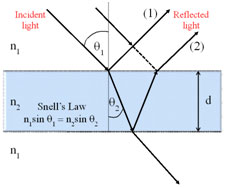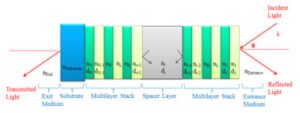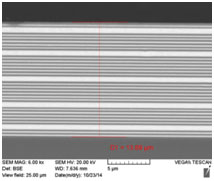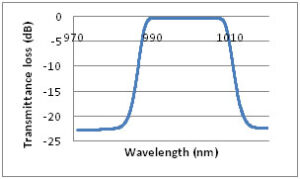Frequently Asked Questions
What are optical thin film filters?
2n2dcos(Θ2) = m λ


At Iridian we put this basic thin film physics to work by depositing onto substrates (typically glass) optical thin film filters consisting of alternating layers of high and low refractive index materials. Often these layer stacks consist of 10’s to 100’s of individual layers.The individual layer thicknesses are on the order of 10 nm to 1000 nm thick depending on the spectral range of the optical filter(the layers thickness are often ¼ of the wavelength region of interest). The result is selective transmission and reflection of specific wavelength bands dependent on the effective thickness of the film and the layer structure deposited.


How are optical thin film filters manufactured?
Optical thin film filter software is employed by thin film engineers to design the thin film multilayer based on the chosen materials and required optical and physical specifications. In order to realize the desired optical performance, the optical constants of the deposited thin film materials need to be accurate and the layer thicknesses tightly controlled, typically to within 1 nm, for deposition runs that can last from a few hours to several days. Modern thin film deposition systems employ in-situ optical monitoring to ensure that the layers are accurately deposited;the control software can then automatically adjust subsequent layers based on the in-situ feedback to produce the desired final filter shape.
What functions do optical thin film filters perform?
Optical filters are used in diverse applications:
- optical telecommunication networks and data centers
- wavelength division multiplexing (WDM), fiber amplifier gain flattening (GFF)
- analytical/spectroscopic instruments; Fluorescence or Raman imaging and analysis
- biomedical analysis, airport/haz-mat/process material scanning
- remote sensing/detection
- gas detection,Earth observation from satellites, LIDAR
- consumer entertainment
- projection displays, 3D cinema
- many other areas!
What should I look for in selecting a supplier of optical thin film filters?
It is also critical that your supplier follows and is certified to a quality management system (such as ISO9001:2015) and that they have a team in place to support the filter from initial concept through to volume production if needed. Finding a supplier with the integrity to “ask permission rather than forgiveness” in negotiating upfront deliverables such as performance and lead-time up and that is available to support questions throughout the build and product life-cycle is invaluable.
What are the advantages of Iridian’s optical thin film filters?
- Can be fabricated in small or large sizes (from <1.0×1.0×0.15 mm to >150×300×20 mm)
- Are environmentally very stable (when using an energetic deposition process such as sputtering)
- Can have customized spectral performance
- Can be designed to have either a very small or a large wavelength shift with temperature
- Work over a broad wavelength operating range
- Can be prototyped quickly and affordably
- Can be manufactured repeatedly in high volumes
- Have a long history of use and are an established technology
What are the names of the various wavelength ranges?
- UV (250-380 nm) [UV = Ultra-Violet]
- VIS (380-750 nm) [VIS = Visible]
- NIR (750-1400 nm) [NIR = Near Infra-Red]
- SWIR (1.4-3.0 µm) [SWIR = Short Wavelength Infra-Red]
- MWIR (3.0-8.0 µm) [MWIR = Mid Wavelength Infra-Red]
-
LWIR (8.0-15 µm) [LWIR = Long Wavelength Infra-Red]
In addition, for Telecom applications, there is a set of bands defined that are commonly used:
| Band | Description | Wavelength range |
|---|---|---|
| O band | Original | 1260–1360 nm |
| E band | Extended | 1360–1460 nm |
| S band | Short | 1460–1530 nm |
| C band | Conventional | 1530–1565 nm |
| L band | Long | 1565–1625 nm |
| U band | Ultra-Long | 1625–1675 nm |
How should I specify custom requirements for an optical thin film filter when requesting a quote?
For a specific filter product types, additional specifications are usually required. For example,
- Gain Flattening Filters (GFF) –
Need to specify: Target transmittance curve along with desired Peak-to-Peak Error Function (PPEF) - Solid Etalons –
Need to specify: Free Spectral Range (FSR), Finesse (F) and FSR temperature variation. - Single Cavity Etalons –
Need to specify: -3 dB bandwidth (equivalent to the Full-Width, Half-Maximum (FWHM) is specified - Bandpass, Edge Pass Filters –
Need to specify: transmit and reflect band(s) and allowed insertion loss (IL), ripple and blocking levels
How do I generate a Request For Quotation (RFQ)?
What information is needed for a Purchase Order (PO)?
- Quotation number and date,
- Preferred courier and your account number with that courier,
- If you are a first time buyer and request a 30 days credit, please include credit ref


